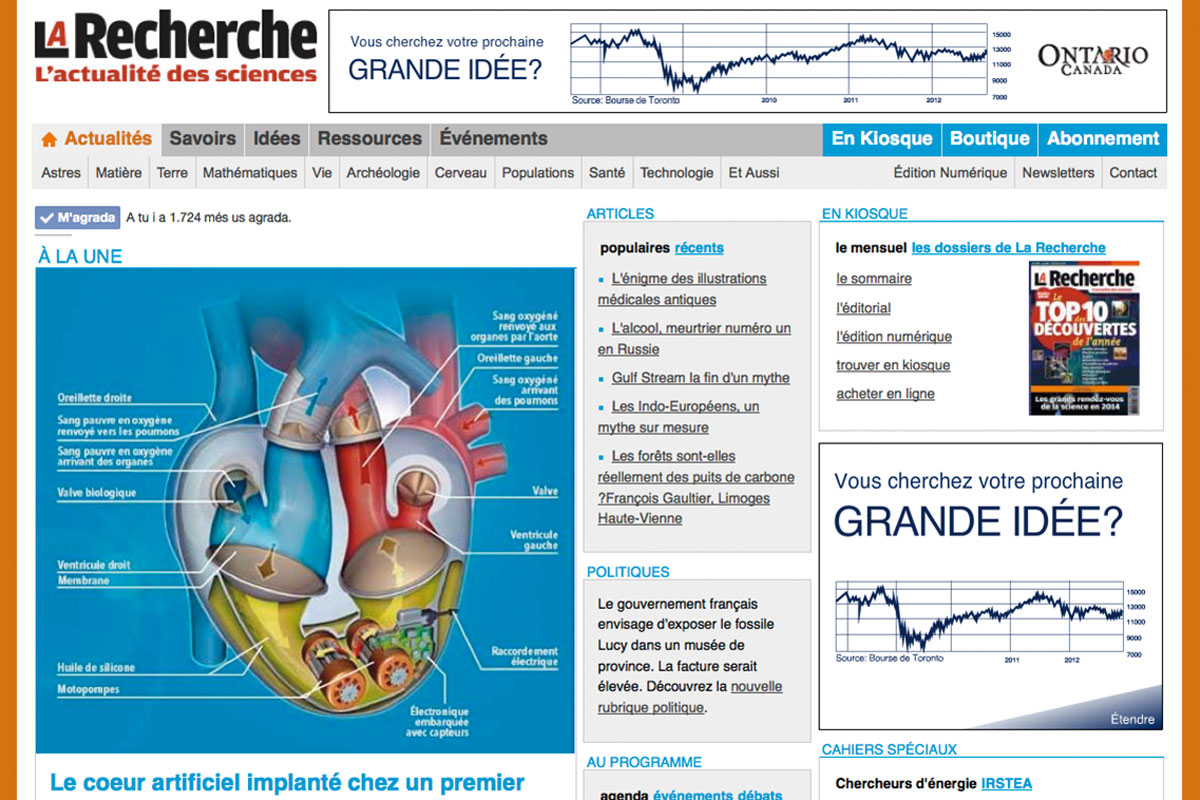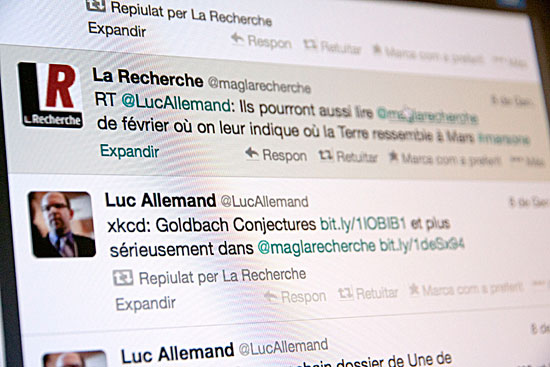Will the Internet save or condemn science press?
The experience of French magazine 'La Recherche'

ABSTRACT
The Internet started to develop just 20 years ago but during that brief period it has shaken up the communications landscape, starting with the written word. Printed newspapers have had to adapt to this new scenario. Here, we present the panorama of science communication in France from the perspective of the monthly magazine La Recherche and other French media sources.
Keywords: science communication, Internet, social networks, magazines, France
La Recherche is a monthly French popular science magazine created in May 1970. Bearing in mind that progress rests largely upon science in today’s world, our editorial proposal seeks to understand working methods, as well as scientific achievements. Thus our readers will be better able to take an informed stand in social debates, such as those sparked by GMOs, nanotechnology, alternative energy sources, bioethics or the protection of privacy on the Internet. La Recherche is special in that some of its articles are signed by the researchers themselves; indeed, our proposal is to open up a kind of direct access to scientists.
La Recherche ranks third out of the French monthly science magazines on the market today. The best selling science magazine is Science et Vie (with 338,000 copies sold each month in France and abroad). Next comes Science et Avenir (with 270,500 copies) and far behind this in third place is La Recherche, with just 38,600 copies. Finally, Pour la Science, the French edition of Scientific American, ranks fourth with 32,000 copies (all figures are for 2012).
The Internet started to develop just 20 years ago but during that brief period it has shaken up the communications landscape, starting with the written word. Printed newspapers have had to adapt to this new scenario. Here we ask how the Internet and the latest technical innovations have influenced science magazines. But to answer this question we must address two other questions. Firstly, whether or not magazines run a website and, if so, what it offers readers. Secondly, we will see how the recent evolution and growth of social networking has blurred the boundaries between professional journalists and amateurs, and especially between the media and research centre press offices.
SURVIVAL OF PAPER
We shall start with magazines. How has the Internet changed them? The first answer is: not at all! So, La Recherche is still a paper printed monthly magazine, as it has been for the last 43 years. And so are the special issues and supplements. In fact for several years now, the magazine has been using up more paper than ever because, counting the different supplements, it currently publishes twenty issues a year compared to the dozen it issued fifteen years ago.
Nowadays, La Recherche is sold mainly on paper. The readers buy paper printed newspapers and magazines, and advertising takes the same form. And although there’s an app for iPad (and soon another for Android), it is just a copy of the print version, generated from the same computer documents. The income directly attributable to electronic publications is still trivial.
However, La Recherche has run a website since 1995, which hosts the archives of the printed version. All the articles published since 1996 are scanned in a simplified format and text without illustrations, with the exception of some graphics. Access to items can be purchased and is free for subscribers.
Moreover, the website advertises the paper journal. It does so directly, listing publications and their abstracts, allowing users to browse a dozen pages of each issue, or providing free access to certain articles from the latest issue. But the promotion of the magazine from a broader perspective, what people call marketing «La Recherche brand», is also done indirectly by posting computerized documents and blogs. In fact, for certain types of news, a very short text is published on the front page with links to the articles – saved as files – which help promote a better understanding of science. La Recherche aims to show it is a «benchmark publication» and regular readers will be the first to become aware of the important things happening in the field of science, or at least have the intellectual tools to understand them.
What I have just described for La Recherche is also true for its competitors, which are currently available for iPad and Android tablets. Those I have checked are again mere electronic copies of the printed journals (the same files in a different format, nothing else). However, some are beginning to include income figures for the sales of these applications as part of their total distribution, which may indicate future growth strategies are moving in this direction. But everyone keeps their trade secrets very quiet.
«Internet has shaken up the communications landscape. Printed newspapers have had to adapt to this new scenario»
PRESENCE ON THE INTERNET
All these magazines have also been running their own websites, for some time, without this fact having changed the printed product. If we take a look at these sites today, they are very similar in terms of content, providing some news but essentially advertising the paper issues. The type of news prepared specifically for the website or just copied from the magazine varies. Obviously, this depends on the human resources they allocate to updating the web. In 2012, Science et Avenir recruited several journalists who are devoted exclusively to updating their web.
The importance attached to making a profit from digitalized back issues also varies widely. For example, Science et Vie, the last to establish a website, has digitized issues from twenty years ago and enthusiastically promotes these documents (with paid access). You can also access back issues of Pour la Science, sorted by date or download individual articles for a small fee you can, but those of Science et Avenir are well hidden, if they exist at all.
Although French popular science magazines focus on the printed version, they may also run blogs. For instance, La Recherche offers researchers the possibility of running blogs related to their work, with a predetermined duration such as a few months or weeks. For example, blogs published during paleontological or archaeological expeditions, a «blog of the month» preceding the launch of the Planck satellite, or others linked to exhibitions. It is difficult to assess to what extent they have been successful with the public as audiences cannot be measured, but they are almost always of high quality.
La Recherche has chosen this type of temporary blog because experience shows that it is extremely difficult for researchers to update blogs unless they are paid for their work, as they would be for running a column in the magazine. Although some studies suggest that it is better for scientists have their own blogs (Blanchard, 2011), the reality is that researchers have little free time and some are reluctant to publish inaccurate texts.
During a conversation held in December 2012, the physicist Marc Lachièze-Rey, who has written many popular books and formed part of La Recherche editorial staff, said – shortly after opening a blog on the website of the French Huffington Post that he should spend more time on it. He said he was worried about the quality of his articles, regarding both the drafting and the accuracy of sources. In fact, after posting six articles between December and March, he did not post any between March and September.

On the French market, monthly scientific journals, such as Science et Vie, Science et Avenir, La Recherche o Pour la Science have had to adapt to the online media channels. All these printed publications have their own websites, although this fact has not changed their print production much. / Photo: Mètode.
Nowadays, most scientists in France who have ongoing blogs are paid for this outreach activity; and many are journalists. Most researchers who started blogs some years ago have returned to their research work. In early August 2013, a quick check of the 45 blogs on the www.cafe-sciences.org platform showed that only 23 updated them regularly, half of which corresponded to journalists, students and professionals in communications media. This analysis did not consider when these blogs were started or the quality of publications.
With respect to the other French popular science magazines, for the moment Science et Vie has refrained from running blogs, Science et Avenir has only four – all run by in-house journalists –, and Pour la Science launched a platform called SciLog in June 2013, which hosts researchers’ and journalists’ blogs. We do not know whether researchers are paid for this work and it is too early to judge whether they keep up with their readers.
A few years ago, Le Monde was the daily that ran the largest number of science blogs, but most have disappeared now. The only one that is still active today is by the blogger Peter Bartholomew, an ex-journalist of the newspaper, who -in a manner of speaking- has «sold» his blog to the newspaper’s website, www.lemonde.fr. Undoubtedly, it will not retain its current blog format for long because last August the author announced on Twitter that he was to take on more responsibilities for running the science section of this website.
To finish this brief tour of the current blog scenario, we must mention the {Sciences2} blog run by Sylvestre Huet hosted on the Libération website. The author is the specialist science journalist for this journal. In his blog he posts items (sometimes in an extended version) published in the newspaper, press releases that could not be published in the newspaper and, occasionally, articles actually written for the blog.
Similarly, La Recherche website hosts only one regularly updated blog related to books, run by a member of a university, who also contributes to the magazine and is paid for this collaboration. September 2013 saw the creation of Astroparticulier, another ongoing project with prospects of continuity, run by a scientist in charge of disseminating the activities run by his research centre. We’ll see if it is successful.
«French popular science magazines focus on the printed version but may also run blogs»
SOCIAL NETWORKS AND OUTREACH
Obviously, Internet presence is not limited to websites. Recent years have witnessed the development and growth of new networks such as Facebook, Twitter, Tumblr, Pinterest, Instagram, Google+, etc., based on the exchange of information between followers and subscribers. Here, we will refer only to the first three, because La Recherche is not present in the others, and it is difficult to assess the policy of the other journals in this area (what is more, this could change at any time!). Again, La Recherche has two objectives: to advertise the paper magazine by redirecting readers to access points and to popularize the brand image.
In practice, the magazine continues to take the leading role today. Posting regularly on Facebook or Twitter is time-consuming and does not provide immediate financial profits, so it is not considered an investment.
Moreover, regarding Facebook, the policy changes between groups, personal pages, business pages, make it easy to miss. On September 4, 2013 La Recherche had very few Facebook contacts: just 667. In fact it is limited to adding contacts to Twitter. Meanwhile, Twitter @maglarecherche had 7,606 followers on September 3, 2013, followed 181 and had 1348 tweets. The Recherche twitters or retweets link solely to the magazine’s website.
Thus, the magazine provides a minimum service through these new sites. But the particular character of these media channels has brought about something quite new: the presence of journalists in the public domain. In fact, some writers have personal Facebook pages which they run as they like1, as well as being on Twitter, such as @alinerichard, @sophiecoisne, @lucallemand, @remicanali, just to name those who tweet regularly. I personally tweet links to the La Recherche website, as the magazine’s official account does. But not just that, I also post links I have discovered in the course of my explorations for my followers. I do this to share my interests with them, and sometimes to engage in dialogue; «humanizing» La Recherche a bit, if you like.

Despite running a website, La Recherche is currently sold mainly in the printed version. Access to the web is free only to subscribers of the paper journal. Photo: Mètode.
I should also mention two attempts made with Tumblr. The first was a copy of «This is what a scientist looks like», a photo gallery of researchers with a brief comment (all led by scientists themselves). The idea is to show that researchers are ordinary people, but do interesting things. In short, an endeavour to create a scientists’ community space, and allow science lovers to identify with them. So we have created «Un chercheur ça ressemble à ça». After an initial boom in which researchers sent thirty photograph, activity of this Tumblr slacked off due to a lack of time and failure to encourage scientists to participate, because they did not opt to publish spontaneously (or did so very seldom).
The second attempt on Tumblr was entitled «Science: the parody of the day». This consisted of a collection of videos on Youtube related science: science parodies of popular songs, original songs, or songs by «real» singers that have some connection with science. The initial idea was also to create a small community around a potentially fun and educational topic. This Tumblr, which I took upon myself to encourage solo, has been inactive for some months now, again due to a lack of time (and to some extent a lack of followers too).
«It is extremely difficult for researchers to update blogs unless they are paid for their work»
COMPLEXITY OF INTERNET
So after sketching this overview of French scientific journals and their journalists on the Internet, what conclusions can we draw? First of all, this activity does not differ much from what many amateurs do. When there were only websites, Internet remained out of reach for many people. But Facebook, Twitter or Tumblr changed this as creating a page has become very easy, and the format is the same for everyone. The only difference is that journalists, who follow the news because it is their job, can offer more and better content than the average user. That is in theory but it has to be demonstrated. One may also imagine that eventually, as has happened with blogging, the continued presence of newspapers and journalists assures them notoriety and a reputation that would allow them to excel. But we still lack perspective.
A second observation is that for professionals, ultimately, the risk of being confused with amateurs is not the worst because if those responsible for the newspaper deem it necessary they can show the difference by investing time and money in Internet channels. Another risk of confusion that is much more annoying is that all these communication channels are also used by scientific institutions: not just universities and organizations such as the Centre National de la Recherche Scientifique (CNRS), el Commissariat à l’Énergie Atomique et aux Énergies Alternatives (CEA) and the Institut National de Recherche en Informatique et en Automatique (lNRIA), but also the public institution responsible for scientific culture, Universcience.
The CNRS website also has news, videos extracted from films made by the centre’s audiovisual service by professional filmmakers, and links to public events. The CEA is somewhat more institutionalised, but even so it posts links to the website on its home page with news about scientific discoveries, encyclopaedic resources and videos presenting researchers and laboratories. One more example is the website home page of the Centre National d’Études Spatiales (CNES) which is full of links to pictures, videos, news…
The network has become an extension of Universcience, a public body responsible for outreach, previously confined to its Paris headquarters. Besides promoting exhibitions on the web, it offers current articles, library resources and even a television network exclusively on science.
One can hardly criticize government agencies for wanting to inform the public about their activities. But we must recognize that they exclude the once mandatory intermediary against which they now compete: the press. Indeed social networks are affecting and changing the role of journalists as regulators and facilitators of public discourse (Hermida et al., 2012). These institutions compete directly with magazines like La Recherche by broadcasting their professional services on the network. Now anyone can download an electronic edition of the institutional journals of these organizations, which previously had restricted dissemination capacity and never through press distribution channels, just as they can with La Recherche but with an added bonus: they are free! Press releases previously only broadcast by journalists are currently posted on web pages and announced through Twitter and Facebook. Anyone can follow CNRS and CEA activities with these apps, or directly consult information posted on the free section of their websites.

Potential Internet presence is not limited to websites. La Recherche, like other publications, implements social networks like Twitter or Facebook to promote the printed magazine and publicize its brand image. / Photo: Anna Mateu.
Primary information can also be gathered on the Internet, something previously reserved for journalists and the press. Some newspapers also play with ambiguity to enhance their websites for free. For example, Futurapolis, the website set up by the weekly Le Point to accompany an annual conference in Tolosa, presented magazine articles and content produced by the CNRS and INRIA on the same page. The CNRS also provides them with images and videos. While articles published on INRIA’s website are alongside AFP dispatches and articles by journalists of Le Point.
Last spring the French edition of the Huffington Post created a section entitled «Les têtes chercheuses» to «provide a platform for the most reputable experts on a topic and bridge the gap between these specialists and the general public». In fact, when we read the explanatory notes carefully it is clear that this site has come to an agreement with the press offices of several research centres, which actually write the articles. There is a fine line separating communication and information. You cannot brush this fact aside saying that after all it is just the Huffington Post that resorts to these practices: on the web, all publishers seek free information, just like their readers.
«Posting regularly on Facebook or Twitter is time-consuming and does not provide immediate financial profits, so it is not considered an investment»
These last two examples are, first, reassuring in that the editors aspire to reach a wide audience and think that science is interesting, at least commercially (their goal is to attract as many Internet users as possible to raise the price of advertising banners). That leaves some room for magazines like La Recherche to hope. On the other hand, however, we should be concerned because they generate confusion between information and institutional communication. Corporate information sources are generally little more than advertising and public relations (Bubela et al., 2012). Also, we find increasingly fewer journalists working for the press while those working for press offices grow in number. Therefore, research institutions are becoming influential on what the public reads about their work (Brumfield, 2009) with information presented as if the research centres were neutral in the choice of topics and how they are portrayed. How would readers react if Le Point mingled articles written by the Ministry of Home Affairs with its own articles in their policy section?
Therefore, beyond the widespread competition that the Internet represents to other media channels (that has been around a 28% decrease in the annual sales of La Recherche in the last five years), it would appear that science outreach like ours entails specific inherent problems. We do not believe that the printed magazine format is outdated, but we are convinced that it can only survive with the support of virtual presence on the Internet, via websites or apps. Furthermore, for its presence in cyberspace to be effective, it must be well planned and have a strong presence, so users can distinguish professionals from amateurs (or even assimilate them, why not?) and, above all, from information posted by the research centres themselves. We have yet to find a way to monetize the investments needed, because we cannot forget that the press is (also) a business.
1. Personally, for a time I followed separation criteria: I did not have people I did not know personally as "friends" in my profile and created a page to resend others and that was the only activity from my Twitter. The goal was to properly separate my private and public life, but it was a complete failure: the page failed to get more than thirty "I likes". Then I changed my criteria: currently accept all the friend requests on Facebook, where I have created a list of people I do not know. This is an example of how understanding the different Facebook modes is difficult for most users to manage. (Go back)
References
Blanchard, A., 2011. «Science Blogs in Research and Popularization of Science: Why, How and for Whom?». In Cockell, M.; Billotte, J.; Darbellay, F. and F. Waldvogel (dir.). Common Knowledge: The Challenge of Transdisciplinarity. EPFL Press. Lausana. Available at: <http://bit.ly/1lTF3lp>.
Brumfield, G., 2009. «Supplanting the Old Media?». Nature, 458(19): 274-277. DOI: <10.1038/458274a>.
Bubela, T. et al., 2009. «Science Communication Reconsidered». Nature Biotechnology, 27(6): 514-518. DOI: <10.1038/nbt0609-514>.
Hermida, A.; Fletcher, F.; Korell, D. and D. Logan, 2012. «Share, Like, Recommend. Decoding the Social Media News Consumer». Journalism Studies, 13(5-6): 815-824. DOI: <10.1080/1461670X.2012.664430>.





